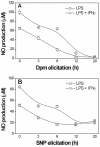Suppression of nitric oxide production in mouse macrophages by soybean flavonoids accumulated in response to nitroprusside and fungal elicitation
- PMID: 15102332
- PMCID: PMC408346
- DOI: 10.1186/1471-2091-5-5
Suppression of nitric oxide production in mouse macrophages by soybean flavonoids accumulated in response to nitroprusside and fungal elicitation
Abstract
Background: The anti-inflammatory properties of some flavonoids have been attributed to their ability to inhibit the production of NO by activated macrophages. Soybean cotyledons accumulate certain flavonoids following elicitation with an extract of the fungal pathogen Diaporthe phaseolorum f. sp. meridionalis (Dpm). Sodium nitroprusside (SNP), a nitric oxide donor, can substitute for Dpm in inducing flavonoid production. In this study, we investigated the effect of flavonoid-containing diffusates obtained from Dpm- and SNP-elicited soybean cotyledons on NO production by lipopolysaccharide (LPS)- and LPS plus interferon-gamma (IFNgamma)-activated murine macrophages.
Results: Significant inhibition of NO production, measured as nitrite formation, was observed when macrophages were activated in the presence of soybean diffusates from Dpm- or SNP-elicited cotyledons. This inhibition was dependent on the duration of exposure to the elicitor. Daidzein, genistein, luteolin and apigenin, the main flavonoids present in diffusates of elicited cotyledons, suppressed the NO production by LPS + IFNgamma activated macrophages in a concentration-dependent manner, with IC50 values of 81.4 microM, 34.5 microM, 38.6 microM and 10.4 microM respectively. For macrophages activated with LPS alone, the IC50 values were 40.0 microM, 16.6 microM, 10.4 microM and 2.8 microM, respectively. Western blot analysis showed that iNOS expression was not affected by daidzein, was reduced by genistein, and was abolished by apigenin, luteolin and Dpm- and SNP-soybean diffusates at concentrations that significantly inhibited NO production by activated macrophages.
Conclusions: These results suggest that the suppressive effect of flavonoids on iNOS expression could account for the potent inhibitory effect of Dpm- and SNP-diffusates on NO production by activated macrophages. Since the physiological concentration of flavonoids in plants is normally low, the treatment of soybean tissues with SNP may provide a simple method for substantially increasing the concentration of metabolites that are beneficial for the treatment of chronic inflammatory diseases associated with NO production.
Figures




Similar articles
-
Nitric oxide synthase-mediated phytoalexin accumulation in soybean cotyledons in response to the Diaporthe phaseolorum f. sp. meridionalis elicitor.Plant Physiol. 2002 Nov;130(3):1288-97. doi: 10.1104/pp.005850. Plant Physiol. 2002. PMID: 12427995 Free PMC article.
-
Suppression of nitric oxide production in activated murine peritoneal macrophages in vitro and ex vivo by Scrophularia striata ethanolic extract.J Ethnopharmacol. 2009 Jul 6;124(1):166-9. doi: 10.1016/j.jep.2009.03.042. Epub 2009 Apr 5. J Ethnopharmacol. 2009. PMID: 19527828
-
Nitric oxide induces ADP-ribosylation of actin in murine macrophages: association with the inhibition of pseudopodia formation, phagocytic activity, and adherence on a laminin substratum.Cell Immunol. 1996 Nov 25;174(1):25-34. doi: 10.1006/cimm.1996.0290. Cell Immunol. 1996. PMID: 8929451
-
Direct activation of murine peritoneal macrophages for nitric oxide production and tumor cell killing by interferon-gamma.J Interferon Cytokine Res. 1995 May;15(5):387-94. doi: 10.1089/jir.1995.15.387. J Interferon Cytokine Res. 1995. PMID: 7648440
-
Extract of the seed coat of Tamarindus indica inhibits nitric oxide production by murine macrophages in vitro and in vivo.Food Chem Toxicol. 2004 Apr;42(4):649-58. doi: 10.1016/j.fct.2003.12.001. Food Chem Toxicol. 2004. PMID: 15019190
Cited by
-
Genistein improve nicotine toxicity on male mice pancreas.Anat Cell Biol. 2019 Jun;52(2):183-190. doi: 10.5115/acb.2019.52.2.183. Epub 2019 Jun 30. Anat Cell Biol. 2019. PMID: 31338235 Free PMC article.
-
Nitric Oxide as a Target for Phytochemicals in Anti-Neuroinflammatory Prevention Therapy.Int J Mol Sci. 2021 Apr 30;22(9):4771. doi: 10.3390/ijms22094771. Int J Mol Sci. 2021. PMID: 33946349 Free PMC article. Review.
-
Protective action of a hexane crude extract of Pterodon emarginatus fruits against oxidative and nitrosative stress induced by acute exercise in rats.BMC Complement Altern Med. 2005 Aug 17;5:17. doi: 10.1186/1472-6882-5-17. BMC Complement Altern Med. 2005. PMID: 16107219 Free PMC article.
-
Animal Models of Inflammation for Screening of Anti-inflammatory Drugs: Implications for the Discovery and Development of Phytopharmaceuticals.Int J Mol Sci. 2019 Sep 5;20(18):4367. doi: 10.3390/ijms20184367. Int J Mol Sci. 2019. PMID: 31491986 Free PMC article. Review.
-
Elucidation of the Metabolite Profile of Yucca gigantea and Assessment of Its Cytotoxic, Antimicrobial, and Anti-Inflammatory Activities.Molecules. 2022 Feb 16;27(4):1329. doi: 10.3390/molecules27041329. Molecules. 2022. PMID: 35209125 Free PMC article.
References
-
- McClure JW. Physiology and functions of flavonoids. In: Harborne JB and Mabry IJ, editor. In The Flavonoids. New York: Academic Press; 1975. pp. 970–1055.
Publication types
MeSH terms
Substances
LinkOut - more resources
Full Text Sources

